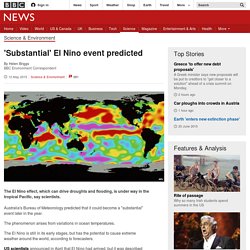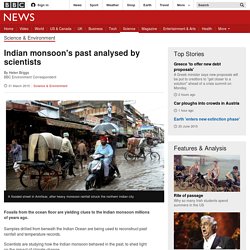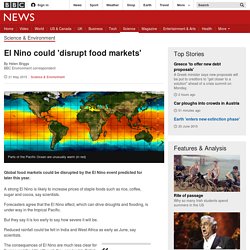

The Water Cycle for Schools and Students. The water cycle describes how Earth's water is not only always changing forms, between liquid (rain), solid (ice), and gas (vapor), but also moving on, above, and in the Earth.

This process is always happening everywhere. Back to the water cycle diagram for students. Animals In the grand scheme of the water cycle, animals may not play a very big role, but all animals, including you, participate in moving water around as part of the water cycle. The water cycle is critical to all animals and life on Earth. There is one creature on Earth that does have a very large impact on the water cycle—human beings.
Atmosphere. 'Substantial' El Nino event predicted - BBC News. The El Nino effect, which can drive droughts and flooding, is under way in the tropical Pacific, say scientists.

Australia's Bureau of Meteorology predicted that it could become a "substantial" event later in the year. The phenomenon arises from variations in ocean temperatures. The El Nino is still in its early stages, but has the potential to cause extreme weather around the world, according to forecasters. US scientists announced in April that El Nino had arrived, but it was described then as "weak". Australian scientists said models suggested it could strengthen from September onwards, but it was too early to determine with confidence how strong it could be. "This is a proper El Nino effect, it's not a weak one," David Jones, manager of climate monitoring and prediction at the Bureau of Meteorology, told reporters. An El Nino comes along about every two to seven years as part of a natural cycle. Indian monsoon's past analysed by scientists - BBC News. Fossils from the ocean floor are yielding clues to the Indian monsoon millions of years ago.

Samples drilled from beneath the Indian Ocean are being used to reconstruct past rainfall and temperature records. Scientists are studying how the Indian monsoon behaved in the past, to shed light on the impact of climate change. The research will lead to a better understanding of how the monsoon over India might change, said Dr Kate Littler of the University of Exeter. As part of the larger-scale Asian monsoon, the monsoon over India is formed due to intense heat from the Sun in late spring, which warms the Northern Indian Ocean, along with the plains of northern India and the Tibetan Plateau. This results in 75% of the year's rain falling between June and September.
Simulations of future climate generally suggest a 5-10% increase in monsoon rainfall over India, which could influence the economy and agriculture. El Nino could 'disrupt food markets' - BBC News. Global food markets could be disrupted by the El Nino event predicted for later this year.

A strong El Nino is likely to increase prices of staple foods such as rice, coffee, sugar and cocoa, say scientists. Forecasters agree that the El Nino effect, which can drive droughts and flooding, is under way in the tropical Pacific. But they say it is too early to say how severe it will be. Reduced rainfall could be felt in India and West Africa as early as June, say scientists. The consequences of El Nino are much less clear for Europe and the UK, although they can lead to British winters that are dry with heavy snowfall. "It's likely there will be at least a moderate El Nino this year," said Prof Adam Scaife of the Met Office. "I think there is very good agreement across the different [forecasting] centres that this is coming. " He said there was a 70% chance of a "moderate" El Nino event towards the end of this year that is likely to lead to droughts and crop failures.
Monsoons Climate change. Massive India heat wave 'kills 350' - BBC News. At least 500 people are reported to have died in a heatwave sweeping India, with temperatures reaching 48C (118F) in some areas.

Most deaths have taken place in the southern states of Telangana and Andhra Pradesh, where more than 140 people have died since Saturday. Allahabad in Uttar Pradesh recorded 48C while temperatures rose to above 44C (111F) in the capital, Delhi. Authorities have urged people to stay indoors and drink plenty of fluids. Heatwave conditions have been prevailing in the two worst-affected southern Indian states since mid-April, but most of the deaths have happened in the past week. The worst-hit state has been Andhra Pradesh where 246 people have died from the high temperatures in the past week. "The majority of the victims are people who have been exposed to the sun directly, usually aged 50 and above and from the working classes," news agency AFP quoted P Tulsi Rani, special commissioner of Andhra Pradesh's disaster management department, as saying.
El Niño is back in town. As the infamous Pacific climate event El Niño is declared for 2015, what does this means for weather conditions around the world?

On one hand, it’s an immensely complicated and chaotic climactic phenomenon. But on the other, El Niño is also one of the most predictable weather systems in the world. ‘El Niño is the cornerstone of seasonal forecasting,’ Adam Scaife, professor from the Met Office’s Hadley Centre, tells Geographical. ‘It’s one of the most predictable things on timescales of a few months ahead. So it’s not difficult to make a prediction, but it is difficult to be precise.’